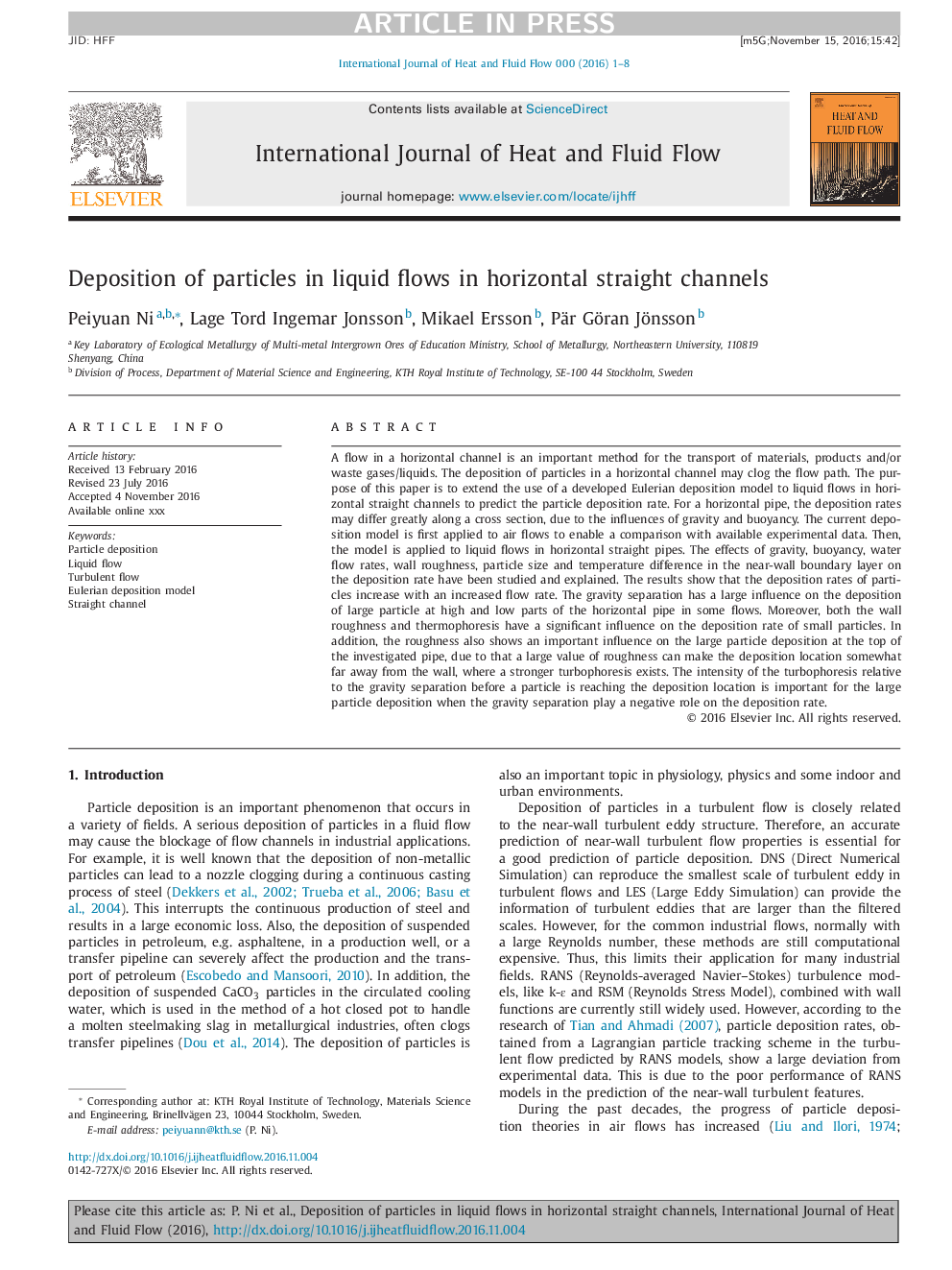| کد مقاله | کد نشریه | سال انتشار | مقاله انگلیسی | نسخه تمام متن |
|---|---|---|---|---|
| 4993225 | 1457617 | 2016 | 8 صفحه PDF | دانلود رایگان |
عنوان انگلیسی مقاله ISI
Deposition of particles in liquid flows in horizontal straight channels
ترجمه فارسی عنوان
رسوب ذرات در جریان مایع در کانال های مستقیم افقی
دانلود مقاله + سفارش ترجمه
دانلود مقاله ISI انگلیسی
رایگان برای ایرانیان
کلمات کلیدی
رسوب ذرات، جریان مایع جریان آشفته مدل رسوب یولر، کانال مستقیم
ترجمه چکیده
جریان در یک کانال افقی، یک روش مهم برای حمل مواد، محصولات و / یا گازهای زباله / مایعات است. رسوب ذرات در کانال افقی ممکن است مسیر جریان را مسدود کند. هدف از این مقاله گسترش استفاده از یک مدل پوشیده شده ی اویلر به جریان مایع در کانال های مستقیم افقی برای پیش بینی میزان رسوب ذرات است. برای یک لوله افقی، میزان رسوب ممکن است به شدت در طول مقطع عرضی متفاوت باشد، به علت تاثیر گرانش و شناور بودن. مدل رسوب فعلی ابتدا برای جریان هوا جهت مقایسه با داده های آزمایشی موجود استفاده می شود. سپس مدل به جریان مایع در لوله های افقی مستقیم اعمال می شود. اثرات جاذبه، شناوری، سرعت جریان آب، زبری دیوار، اندازه ذرات و تفاوت دما در لایه مرزی نزدیک دیوار بر میزان رسوب گذاری مورد مطالعه و توضیح داده شده است. نتایج نشان می دهد که میزان رسوب ذرات با افزایش سرعت جریان افزایش می یابد. جداسازی گرانش تأثیر زیادی بر رسوب ذرات بزرگ در قسمت های بالا و پایین لوله افقی در برخی جریان ها دارد. علاوه بر این، هر دو زبری دیوار و ترموفورز تاثیر قابل توجهی در میزان رسوب ذرات کوچک دارند. علاوه بر این، زبری نیز تاثیر مهمی بر رسوب ذرات بزرگ در بالای لوله مورد بررسی نشان می دهد، به همین دلیل مقدار زیادی زبری می تواند موقعیت رسوب را تا حدی دور از دیوار، جایی که توربوفورزیس قوی تر وجود دارد. شدت توربوفورز نسبت به جداسازی گرانش قبل از رسیدن ذرات به محل رسوب، برای رسوب بزرگ ذرات مهم است، زمانی که جداسازی گرانش نقش منفی در میزان رسوب دارد.
موضوعات مرتبط
مهندسی و علوم پایه
مهندسی شیمی
جریان سیال و فرایندهای انتقال
چکیده انگلیسی
A flow in a horizontal channel is an important method for the transport of materials, products and/or waste gases/liquids. The deposition of particles in a horizontal channel may clog the flow path. The purpose of this paper is to extend the use of a developed Eulerian deposition model to liquid flows in horizontal straight channels to predict the particle deposition rate. For a horizontal pipe, the deposition rates may differ greatly along a cross section, due to the influences of gravity and buoyancy. The current deposition model is first applied to air flows to enable a comparison with available experimental data. Then, the model is applied to liquid flows in horizontal straight pipes. The effects of gravity, buoyancy, water flow rates, wall roughness, particle size and temperature difference in the near-wall boundary layer on the deposition rate have been studied and explained. The results show that the deposition rates of particles increase with an increased flow rate. The gravity separation has a large influence on the deposition of large particle at high and low parts of the horizontal pipe in some flows. Moreover, both the wall roughness and thermophoresis have a significant influence on the deposition rate of small particles. In addition, the roughness also shows an important influence on the large particle deposition at the top of the investigated pipe, due to that a large value of roughness can make the deposition location somewhat far away from the wall, where a stronger turbophoresis exists. The intensity of the turbophoresis relative to the gravity separation before a particle is reaching the deposition location is important for the large particle deposition when the gravity separation play a negative role on the deposition rate.
ناشر
Database: Elsevier - ScienceDirect (ساینس دایرکت)
Journal: International Journal of Heat and Fluid Flow - Volume 62, Part B, December 2016, Pages 166-173
Journal: International Journal of Heat and Fluid Flow - Volume 62, Part B, December 2016, Pages 166-173
نویسندگان
Peiyuan Ni, Lage Tord Ingemar Jonsson, Mikael Ersson, Pär Göran Jönsson,
